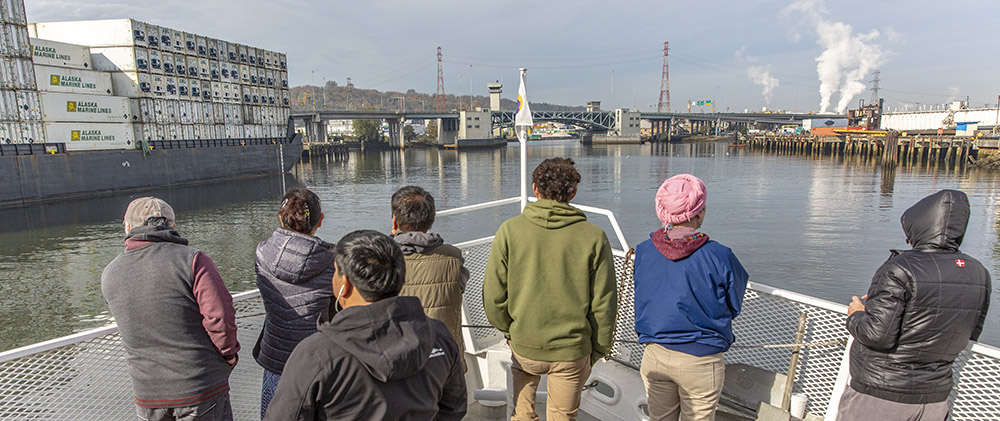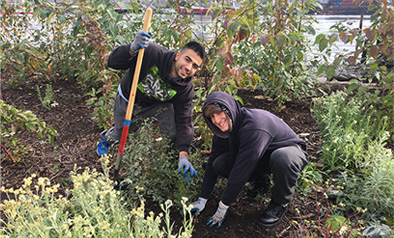This page may be viewed in: English
The members of LDWG work with many partners in the region to improve the health of the Duwamish River through habitat restoration, improved water quality, reducing pollution, and educating the public about the importance of a healthy Green-Duwamish watershed. You can play a part in cleaning up the river too.
Get Connected
There are many ways to learn more about the Duwamish. We’ll keep the community updated on events and opportunities to get involved.

![]()
Duwamish River Community Coalition
Connect with community members who are involved with their river cleanup as part of the EPA’s Technical Advisory Group through the DRCC.
Duwamish Waterway Roundtable
Learn more about the cleanup effort by following the EPA’s Lower Duwamish Waterway Roundtable’s regular meetings.
Port of Seattle: Duwamish River Educational Boat Tours
The Port of Seattle offers educational boat tours to raise awareness about the Duwamish River, history, and local economy.
Volunteer

Duwamish Alive is a coalition of nonprofit groups and government agencies dedicated to improving the health of the Duwamish River for the people and wildlife that share it. Since 2006, Duwamish Alive events have brought together hundreds of volunteers in April and October to steward restoration sites along the Green Duwamish Watershed. Volunteers pull invasive weeds, plant native shrubs and trees along the river bank, and pick up litter and trash from the rivershed to ensure a safe and healthy environment for salmon recovery and for our communities to enjoy.
Live Green

Your everyday choices can help keep our river clean! Rain that falls on streets, parking areas, sports fields, gravel lots, and rooftops and then flows directly into nearby lakes, rivers and the Puget Sound is called stormwater runoff. Stormwater runoff contains pollutants that are harmful to humans and wildlife. Follow these tips to do your part to reduce pollution in stormwater runoff!
Drive less: Fewer cars on the road means less pollution on the roadways. Use transportation options that reduce the number of motorized vehicles on the road. Bus, carpool, bike, or walk instead!
Car care: Always recycle used oil, antifreeze and other fluids. Fix oil leaks in your vehicles. Wash your car at a commercial car wash rather than in the street or in your driveway to reduce the amount of water filling the storm drain.
Avoid fertilizers, pesticides, and herbicides: Don’t apply chemical lawn care products before a rainstorm, or use only organic brands. Compost or mulch lawn clippings and use natural lawn care methods.
Plant and preserve native species and trees: Native trees, shrubs, and groundcover are the best filters for preventing pollution in stormwater from reaching Puget Sound. Plant native today!
Pet care: Pet waste is toxic to our watershed. Keep animals out of streams, scoop your dog’s poop while on walks, and always properly dispose of it in the garbage.
Pick up litter and reduce plastic waste in your life: Every day we are learning more and more about the importance of reducing our litter and plastics pollution in our waterways. Organize your neighbors to host cleanup events to prevent waste from entering storm drains when it rains. Use fewer plastic products and reduce the amount of trash you throw away! Zero Waste Washington supports communities on how to do it- check it out!
Reduce impervious surfaces: Impervious surfaces include your building’s roof, driveway, and patios. Increase the vegetated land cover of your property or depave cement and brick pathways to allow water to filter through them.
Install green stormwater infrastructure: It’s important that we filter dirty stormwater entering our streams and rivers. Install rain gardens in your neighborhood and encourage businesses you know to filter rain runoff from roofs with rain barrels. Check out King County’s RainWise Program to find discounts and get involved!
Educate yourself and your family about your local watershed: In the face of climate change, learn more to reduce pollution in our watershed, prevent flooding, protect our native wildlife and salmon, and support our community’s resilience!
